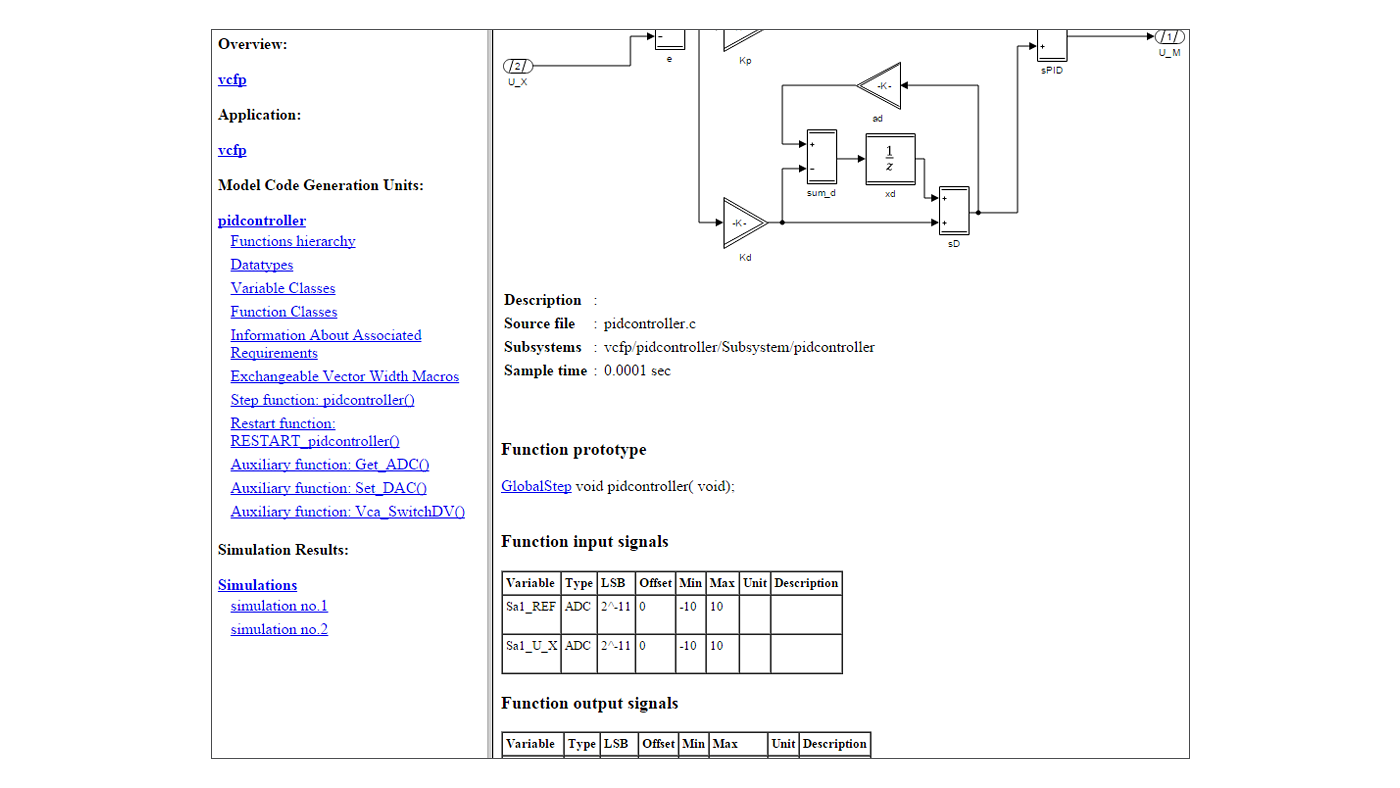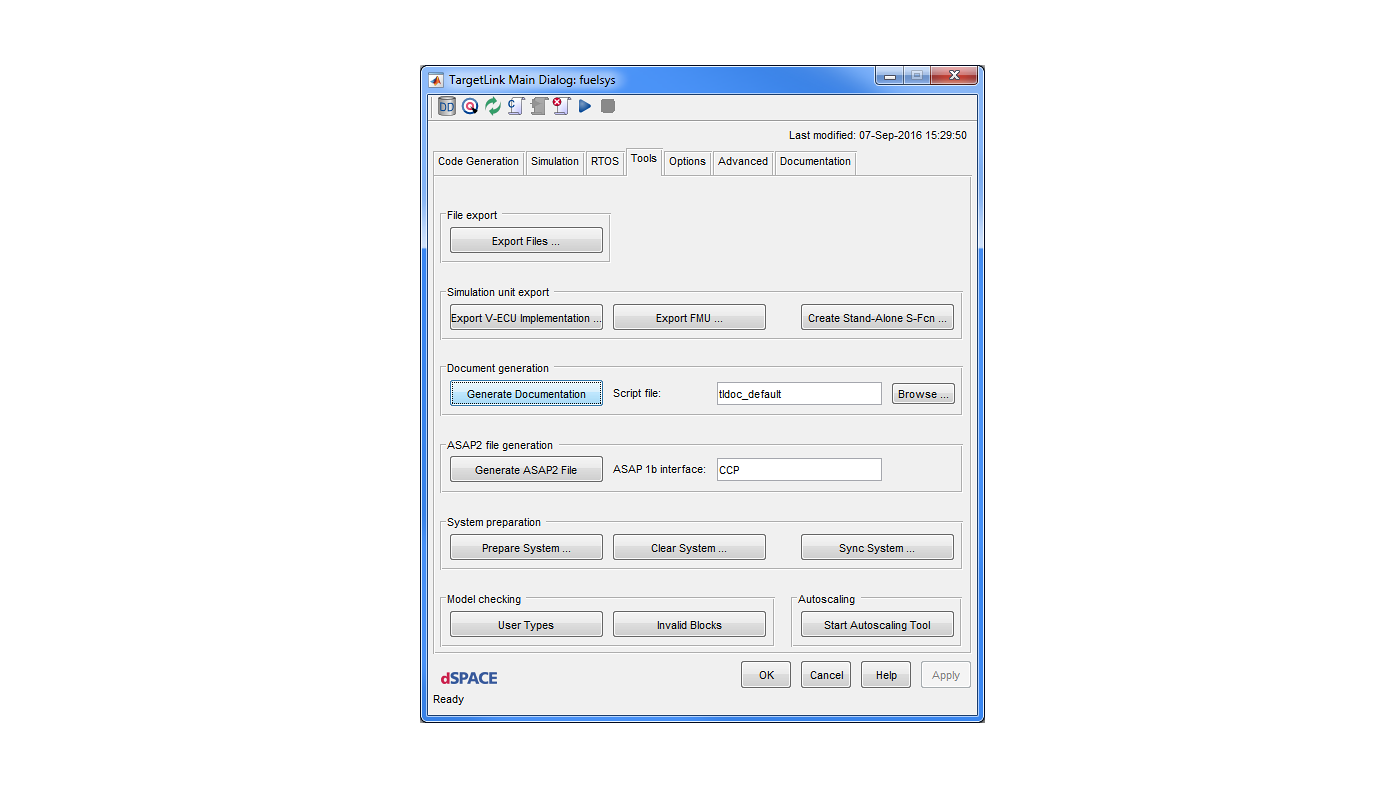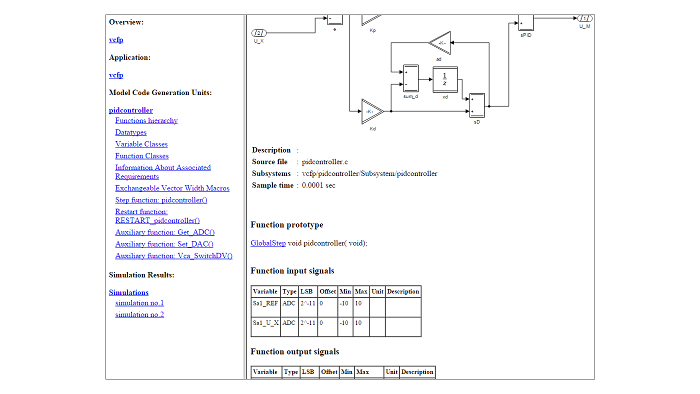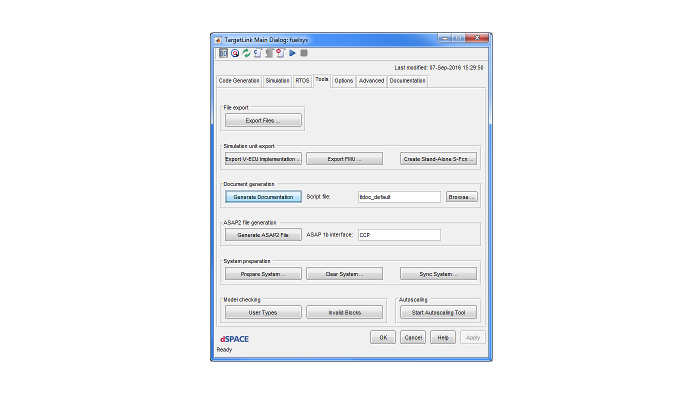Documentation Generated Automatically
TargetLink not only generates code, it also documents what it does – keeping perfect consistency with the model and the code. An automatically generated document provides information about function interfaces and global variables, and a list of all measurable and adjustable variables, scaling parameters, code generator options and much more.
Screenshots of models, subsystems, and simulation plots can also be included. Links to the generated C code are provided. You can specify the documentation you require, for example, the level of detail. Documentation can be generated in the HTML, RTF (for word processing) and PDF formats.
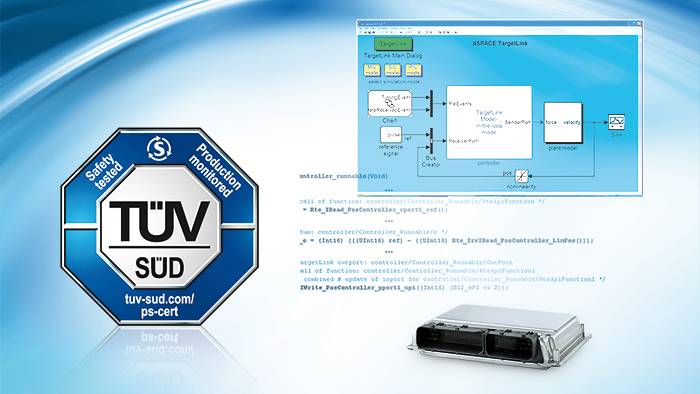
TargetLink est certifié conforme aux normes ISO 26262, ISO 25119 et CEI 61508
Le TÜV SÜD (l’association allemande internationale de certification) a certifié TargetLink comme convenant au développement de systèmes de sécurité. Le TÜV a confirmé que TargetLink était adapté au développement logiciel d’après les normes ISO 26262, ISO 25119, CEI 61508 et leurs dérivés (tels que la norme EN 50128 dont dépendent les logiciels de sécurité relatifs aux chemins de fer). Cette certification recouvre plusieurs domaines :
- Le processus de développement logiciel et le processus de modification logicielle de TargetLink
- Les procédures de gestion de problèmes
- L’aptitude à l’emploi dans le développement de systèmes de sécurité d’après les normes ISO 26262, ISO 25119 et CEI 61508
Le TÜV SÜD a approuvé une procédure de référence proposant un fil directeur pour le développement de logiciels sécuritaires basés sur une modélisation avec TargetLink. La norme CEI 61508 est la norme générique établie au niveau international pour le développement des systèmes électroniques critiques. La norme ISO 26262 est la norme automobile standard pour le développement de systèmes de sécurité dans les véhicules routiers. La norme ISO 25119 est la norme internationale pour le développement des éléments de sécurité des systèmes de commande dans les tracteurs et les machines destinées à l’agriculture et au secteur forestier. Ces deux normes sont dérivées de la norme CEI 61508.

Faits concernant TargetLink et les normes DO-178C/DO-331 en bref
- Des modèles Simulink ® /TargetLink pour la spécification d'exigences de haut niveau
- Des modèles de conception TargetLink pour la spécification d'exigences de bas niveau
- Génération de code source traçables, facile à lire, de grande qualité à partir des modèles TargetLink.
- Un support de simulation complet pour les modèles et le code d'après le concept de vérification MIL/SIL/PIL
- Une chaîne d'outils comportant des outils de BTC Embedded Systems pour la spécification d'exigences, la génération automatique de vecteurs de test, la vérification des exigences et la vérification formelle par contrôle du modèle
Overview of TargetLink Certifications & Standards
TargetLink is certified by TÜV SÜD (German international certification association) for use in the development of safety-related systems. TÜV confirmed that TargetLink is suitable for software development according to ISO 26262, ISO 25119, IEC 61508, and derivative standards (such as EN 50128, which governs safety-related software on the railways). The certification was based on a number of areas:
- Software development process and software modification process of TargetLink
- Problem handling procedures
- Fitness for purpose in safety-related development according to ISO 26262, ISO 25119, and IEC 61508
TÜV SÜD also approved a reference workflow providing guidance for the model-based development of safety-related software with TargetLink. IEC 61508 is the internationally recognized generic standard for the development of safety-related electronic systems. ISO 26262 is the international automotive standard for the development of safety-related systems in road vehicles. ISO 25119 is the international standard for the development of safety-related parts of control systems in tractors and machinery for agriculture and forestry. Both standards are derived from IEC 61508.
| Certification/ Standard | Description |
| ISO/IEC 15504 | ISO/IEC 15504 (also known as SPICE: Software Process Improvement and Capability Determination) is an international standard for software processes. Its underlying concept is that a mature software product requires a mature development process. dSPACE has dedicated itself to an ISO/IEC 15504-compliant development process. |
| An internal quality department, the dSPACE quality management team, proactively manages software quality at dSPACE. The team leads software improvement activities, sets internal standards, conducts internal assessments, and provides consultation services to all software groups. It acts independently and ensures that the highest product quality goals are consistently achieved and sustained. | |
| Internal Software Quality Management | An internal quality department, the dSPACE quality management team, proactively manages software quality at dSPACE. The team leads software improvement activities, sets internal standards, conducts internal assessments, and provides consultation services to all software groups. It acts independently and ensures that the highest product quality goals are consistently achieved and sustained. |
| AUTOSAR | As a de-facto standard for automotive E/E architectures, AUTOSAR contains specifications for communication interfaces between application functions and basic system functions. The TargetLink AUTOSAR Module makes TargetLink’s modeling, simulation and code generation features available for designing Classic AUTOSAR software components (SWCs). Furthermore, TargetLink 5.0 supports select features of Adaptive AUTOSAR Release 19-03. AUTOSAR Adaptive Platform, also called Adaptive AUTOSAR, is a standard based on a service-oriented architecture that aims at on-demand software updates and high-end functionalities. |
| FMI | The Functional Mock-up Interface (FMI) is an open standard for the tool-independent exchange and integration of plant models that are provided by various tool vendors. Functional Mockup Units (FMUs) can be exported from TargetLink to simulation environments that support FMI. |
| ASAM MCD-2 MC (ASAP2) | Internal ECU variables in measurement and calibration can be defined in the description format ASAM MCD-2 MC. Because a code generator also needs to have close links with calibration systems, TargetLink can export calibration data as ASAM-MCD 2MC file for calibration tools. |
| MISRA C | The British MISRA C standard (MISRA: Motor Industry Software Reliability Association; www.misra.org.uk) is a widely accepted C subset for projects in the automotive industry. Its aim is to define rules for avoiding common software errors that can occur when software engineers write software by hand. Most of these rules also make sense for machine-generated code. TargetLink-generated code complies with the vast majority of MISRA C rules. If deviations from the MISRA C standard are a technical necessity, they are identified and well documented. dSPACE provides detailed documentation about TargetLink’s MISRA C compliance to all TargetLink customers on request. |
| DO-178C/DO-331 | With the DO-178C as a highly relevant standard for the development of software in aviation, model-based design and automatic code generation has a solid base for use in the aerospace sector. The document DO-331, Model-Based Development and Verification Supplement to DO-178C and DO-278A, which is also part of the standard, was written specifically for this. dSPACE takes this into account by providing a workflow document that explains how to use TargetLink in a model-based tool chain for DO-178C-compliant projects. The workflow document describes how to meet the individual requirements or objectives of DO-178C/DO-331. It focuses not only on TargetLink itself but also on a complete model-based tool chain that can contain further third-party tools, for example, from TargetLink cooperation partners such as BTC Embedded Systems, AbsInt, and Model Engineering Solutions. The workflow document is thus an important contribution towards simplifying the certification of TargetLink-generated code in DO-178C-compliant applications, addressing all criticality levels up to Level A. |

